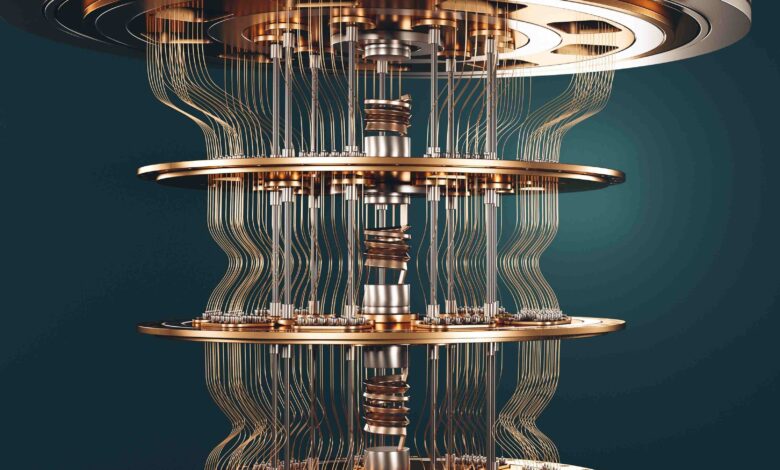
Quantum advantage, provided by the fundamental quantum properties of superposition, entanglement and the quantum parallelism that they provide, is revolutionising the way in which machine learning is delivered. Generative AI is one of the most promising tools for addressing the challenges facing quantum computing. As an example, the ‘Gefion’ supercomputer at the Danish Centre for AI Innovation, forms a part of NVIDIA’s drive to provide quantum supercomputers by integrating quantum hardware and AI supercomputing.
Quantum-assisted machine learning uses qubits, a quantum computer’s equivalent of the transistor in classical CPUs, and quantum operations to improve computational speed. This is especially beneficial to machine learning algorithms which often process immense quantities of data. Quantum-assisted machine learning uses hybrid methods that involve both classical and quantum processing in which computationally difficult tasks are reserved to a quantum processing unit (QPU) where they can be executed more quickly, while data-heavy tasks are assigned to the classical CPU. This model of hybrid quantum-classical computing is now a focus of near-term commercialisation in the quantum computing industry.
Commercialisation, of course, involves protecting valuable IP. The notion of what constitutes a patentable invention differs from one patent office to another around the world, and so it’s not uncommon for the same invention to be patented by one office and yet refused by another. This is particularly so for technologies that rely on mathematically abstract ideas, such as machine learning and quantum computing. The issue at hand is that abstract ideas, including mathematical methods, scientific theories and computer program algorithms, are excluded from being patentable by many patent offices.
Quantum physics and machine learning algorithms each rely heavily on their mathematical formalism and are of an exceedingly abstract quality. This immediately raises the question of whether the task of obtaining patent protection for a quantum computing when applied to machine learning algorithms is more difficult or even impossible before some patent offices.
Patent offices of the UK, Europe and the USA are each grappling with how to assess the patentability of new innovations in quantum computing, and recent legal developments in the UK have cast new doubt on how to assess AI innovations too.
Adversarial neural networks, ANNs, are a cornerstone of the machine learning systems on which many AI systems are based, and software company Emotional Perception AI developed an ANN they wished to patent. Their ANN provides media file recommendations (e.g. songs) to users without relying on categories identified by humans. Instead, it makes recommendations based on the file’s physical properties. The UK Intellectual Property Office (“UKIPO”) rejected the patent application, on the basis that the ANN was a “program for a computer” which excludes it from being patentable.
Emotional Perception appealed against the rejection at the High Court, which overturned the UKIPO’s rejection and concluded that the ANN was not excluded from being patentable. The UKIPO then appealed that High Court decision at the Court of Appeal which reversed the High Court’s decision and reinstated the UKIPO’s original rejection: the ANN was excluded from patentability. Emotional Perception has appealed to the Supreme Court to ask them to reverse the Court of Appeal’s decision. This is the first time that the patentability of AI will be considered at this level by the English Courts.
The UKIPO argue that an ANN is a program for a computer, and that the underlying generic or untrained ANN itself is a computer. They argue that the series of weights and biases which are applied to an ANN represent a computer program essentially because they are what enables it to perform a specified function. This is analogous, they say, to the way that “if, then…” instructions in a generic computer program enable a generic CPU to execute a particular function.
In response, Emotional Perception AI argue that an ANN cannot be separated into components representing a computer and a computer program, i.e. the underlying nodes, links, weights and biases of an ANN. A trained ANN is a composite whole, they argue, which is not a computer: there are no “if-then” statements defining its operation.
The Supreme Court’s hearing is set for 21 July 2025, and their ruling has the potential to shed of light on issues which arise frequently in the handling of patent applications for computer-implemented inventions at the UKIPO – namely, what is a computer program? This applies equally to inventions implemented on a CPU or a QPU, and therefore to the hybrid nature of quantum-assisted machine learning.
Whether concerning a CPU or a QPU, or both, patent offices of the UK, Europe and the USA tend to look favourably on patent applications that frame computer-implemented inventions in terms of a specific technical implementation of the mathematical methods used. The technical application of the methods to a field of technology can be sufficient to move the patent application from the unpatentable realm of the abstract into the patentable zone – at least in principle.
Quite how these patent offices will ultimately view the ‘quantum state’ of qubits in this regard, remains unclear. The quantum states of qubits are fundamental to the properties of superposition and entanglement that underpin quantum advantage in quantum-assisted machine learning. It remains to be seen whether quantum states, and their manipulation within a QPU, will be deemed to be of a merely abstract character or, instead, a real component part of the technical implementation of a quantum computer program that contributes to patentability.





